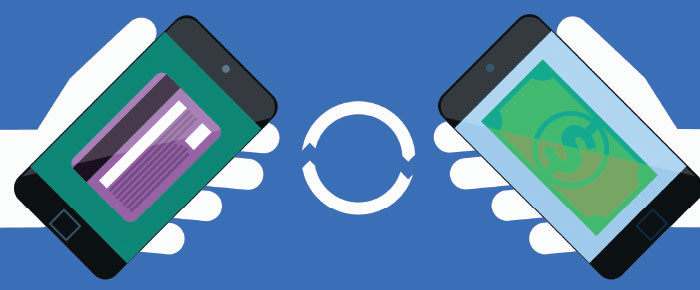
Since the first time one person said to another, “I want what you have,” there has been the need for reliable currency. Initially, that currency consisted of a barter system where people traded the goods and/or services they had for things they needed. That eventually evolved into coins, which in turn evolved into a paper-based system then plastic credit cards and debit cards. Each shift has been made to enable the people involved in the transaction to have a more convenient and secure transactional experience. Today, the market is witnessing an unprecedented evolution into digital currency that changes not only what people buy, but where they shop and how they pay. At the center of this sea change is a system that enables the digital currency to change hands: digital wallets or eWallets.
Considering how technologically advanced humanity is today, it is somewhat surprising that we still carry leather wallets (and purses) that hold all types of plastic cards, coupons, currencies and more. We are just now beginning to understand how to convert these into a digital format, which adds the improvements that one would expect in the conversion process. Consumers are savvy and will not adopt a clunky digital wallet that has less utility than their physical wallet. In the highly competitive world where apps are competing for consumers’ attention, the market has come to expect (if not even demand) meaningful improvements before giving any time to an online app.
eWallets Enable Digital Currency
Long before payment cards (i.e., debit, credit, gift and loyalty cards) and checks were used for payments, currencies were used. Interestingly, as the Internet emerged, the forms of payments more obviously suited for an electronic world sped forward, while national currencies lagged behind. Currencies continue to be a different story. The way to make a currency work electronically while preserving the attributes that make currencies work so well (i.e., immediacy of payment, finality of payment and privacy of the payment to name a few) were not so obvious. However, the understanding of how to make currencies work electronically is beginning to emerge.
For example, it is in just the last few years that there have been news reports of bitcoin and other digital currency making their way into the market. Companies building on the Bitcoin protocol have raised millions of dollars validating business interest in solving this problem.
An eWallet can hold items that are similar to a leather wallet such as ID cards (e.g., digital drivers licenses), coupons, national currencies (i.e., U.S. dollars, euros, Mexican pesos), payment cards (i.e., bank cards—debit and credit, gift cards, loyalty cards, rewards cards). The purpose of an eWallet is to not only create an electronic storage location to hold these types of items but to also add intelligence to them that simplifies our lives. For example, an advanced eWallet will know when one is making a payment at a specific merchant location so it can prompt the user to redeem the value on a gift card (no more worrying about forgetting the gift cards), it can automatically capture the loyalty value applicable to a purchase without requiring the presentment of a specific loyalty card. It may also prompt for the redemption of an applicable coupon held in the wallet. The eWallet may also present consumers with offers from their favorite merchants through an online marketing program.
While technically eWallets can be used internationally, individual countries may have laws and regulations regarding the use of currency, payment cards (e.g., debit and credit cards) and the redemption of gift cards, loyalty cards and coupons. These laws and regulations may even apply when an eWallet is used to hold these items digitally. We are also seeing regulators announcing additional rulings that pertain specifically to digital currency. For example, FinCEN issued administrative rulings in January regarding virtual currency mining operations and virtual currency software development and investment activities. One responsibility a compliance officer has is to reinforce rules and regulations within the organization.
On the other hand, some less developed foreign countries are actually ahead in the adoption of digital currency because the security, and convenience are magnified and represent such a compelling improvement. While the U.S. has been a leader in payments infrastructure, it is seeing other countries leap ahead because of their rapid adoption of mobile technologies, digital currencies and the less developed regulatory environment.
Spotting the Weaknesses
Protecting information from use and abuse by criminals is an ongoing process and continual effort
Protecting information from use and abuse by criminals is an ongoing process and continual effort. The industry is constantly looking for ways to improve the integrity of digital payment systems, including eWallets. A current example is the recent announcement by Apple of Apple Pay. Apple Pay eliminates payment card account numbers by tokenizing the payment card number. A tokenized payment card number is a string of digits that become meaningless when removed from its secure context. Apple Pay also leverages a mobile phone’s Touch ID technology to validate the payer. Validating the person who is making the payment is an important step in protecting the integrity of the payment system. An eWallet does not stand alone. It has to consider security from the outset in order to maintain trust. For example, transparency and privacy are critical elements in building trust. Each transfer of a national currency between eWallets involves three parties: provider or issuer of the national currency (e.g., a financial institution here in the U.S.), a payor and a payee. Transparency means that the stakeholders in the national currency transfer have appropriate access to information to support their roles and responsibilities while also maintaining privacy. Security and control are also critical to building trust. An eWallet provides an opportunity for improving both security and control by simply reversing how a transfer is conducted. By allowing consumers to push the payment to the merchant’s eWallet, instead of having the merchant pull it from the consumer’s eWallet, the control for the payment is returned to the consumer, which also increases security for the consumer and merchant. An eWallet allows push transfers to be completed without requiring the merchant to protect consumer payment accounts (e.g., debit card number, credit card number).
Validating the person who is making the payment is an important step in protecting the integrity of the payment system
Security is a regular, ongoing iterative process of identifying potential weaknesses and fortifying those against unintended use and abuse. Security is comprehensive and important from a systems perspective. Moving cash to a cloud-based eWallet system secures the payment in ways that were previously more difficult or not even possible. For example, preserving the bearer nature of a national currency like the U.S. dollar and electronically anchoring each bill, regardless of denomination, to a unique Web address becomes a way for the public to verify the authenticity of the payment instrument. When all those participating in the system of eWallets can easily verify the integrity of a payment instrument, then the collective trust in the system is increased. The federal government publishes information and encourages public education about the security features of the new $100 bill, so that anyone accepting $100 bills for payment is not easily duped by a counterfeit. When the security features of the payment instrument are difficult, or even impossible to copy but also easily identifiable and verifiable by anyone using the system, including the compliance officer, the collective trust in the system increases. The Bitcoin faithful are quick to refer to the importance of anonymity as a feature of the digital currency; however, it is also important to be able to visually and independently verify the authenticity of the payment instrument and its security features like we can with physical bills.
The way for the compliance officer to mitigate the risk of a digital currency is to dismiss it. The compliance officer should be prepared for discussion in meetings and have identified reasons it is too risky for the organization to be involved with a digital currency directly or indirectly. In regards to the use of digital currency, it is not the job of the compliance officer to further its use—that is the job of the business. Do what you have been hired to do—say “no.” Continue to say no until the security and soundness of the digital currency has been appropriately vetted in the market.
When Digital Currency is at its Most Secure
A digital payment instrument is itself more secure when the authenticity and security features of the payment instrument are shared publically, and visually and independently verifiable. Transfers using a secure digital payment instrument become more secure when possession is tracked, recorded, transparent and private. An eWallet must be worthy of trust at the consumer, ecommerce and financial institution level to succeed long term. Digital currency security is a comprehensive set of attributes, features and functions working together in a system of eWallets to build and maintain integrity and trust of the system.
For decades, the dependable physical wallet has been home to payment cards (e.g., debit/credit), gift/loyalty cards, coupons and cash and it worked well—but the evolution has begun and there is no stopping it now. eWallets are building on that same understanding of how and why they work into a digital experience that simplifies how these items are used online in a mobile world to improve lives even more.










